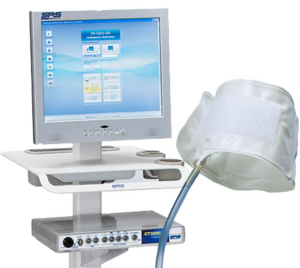
What is UroCuff?
UroCuff is a non-invasive diagnostic tool used by Urologists to evaluate bladder efficiency: bladder function, pressure and urine flow. It is a short, in-office test that is useful for analyzing men who have lower urinary tract symptoms (LUTS) oftentimes caused by Benign Prostatic Hyperplasia (BPH or enlarged prostate).
UroCuff may be recommended for men who are experiencing urinary urgency and/or frequency, frequent trips to the restroom during the night (nocturia), or urinary flow problems such as a poor urine stream, incomplete emptying, dribbling, hesitancy, or urination that starts and stops.
Day of testing – what to expect
UroCuff is a very brief test that takes little preparation by the patient. On the day of the appointment, the patient is asked to drink 32 ounces of water (4 cups) one hour prior to their appointment. They should arrive in the office approximately 10 to 15 minutes early with a comfortably full bladder. When checking in, it is best to notify staff that you are there for UroCuff testing and have a full bladder. Patients should not urinate before being called back for testing.
When preparing for the evaluation, the patient will be asked to disrobe. At this point, a small cuff will be wrapped around the penis (similar to a blood pressure cuff). When instructed, the patient will be asked to urinate into a UroCuff flow meter. They should urinate in a natural fashion without straining or pushing. As they urinate, the cuff will begin to inflate until it disrupts urine flow. At that time, it will deflate allowing urination. This cycle of cuff inflating and deflating will continue until the patient is finished urinating.
During the testing process, UroCuff software will report bladder function based on urine flow rate versus cuff interruption pressure. When the testing is complete, the cuff will be removed. At that time, an ultrasound of the bladder will be performed to determine post-void residual (how much urine is still in the bladder after the patient finished urinating). With the information from UroCuff testing, combined with the ultrasound results, the provider will be able to make a more accurate diagnosis and treatment plan. Over time, the UroCuff test can be repeated to help gauge how effective the treatment has been.
If you’re experiencing urinary issues such as urgency, frequency, or a change in your urine stream, contact Urology Austin to schedule an appointment with one of our providers.
Related link
